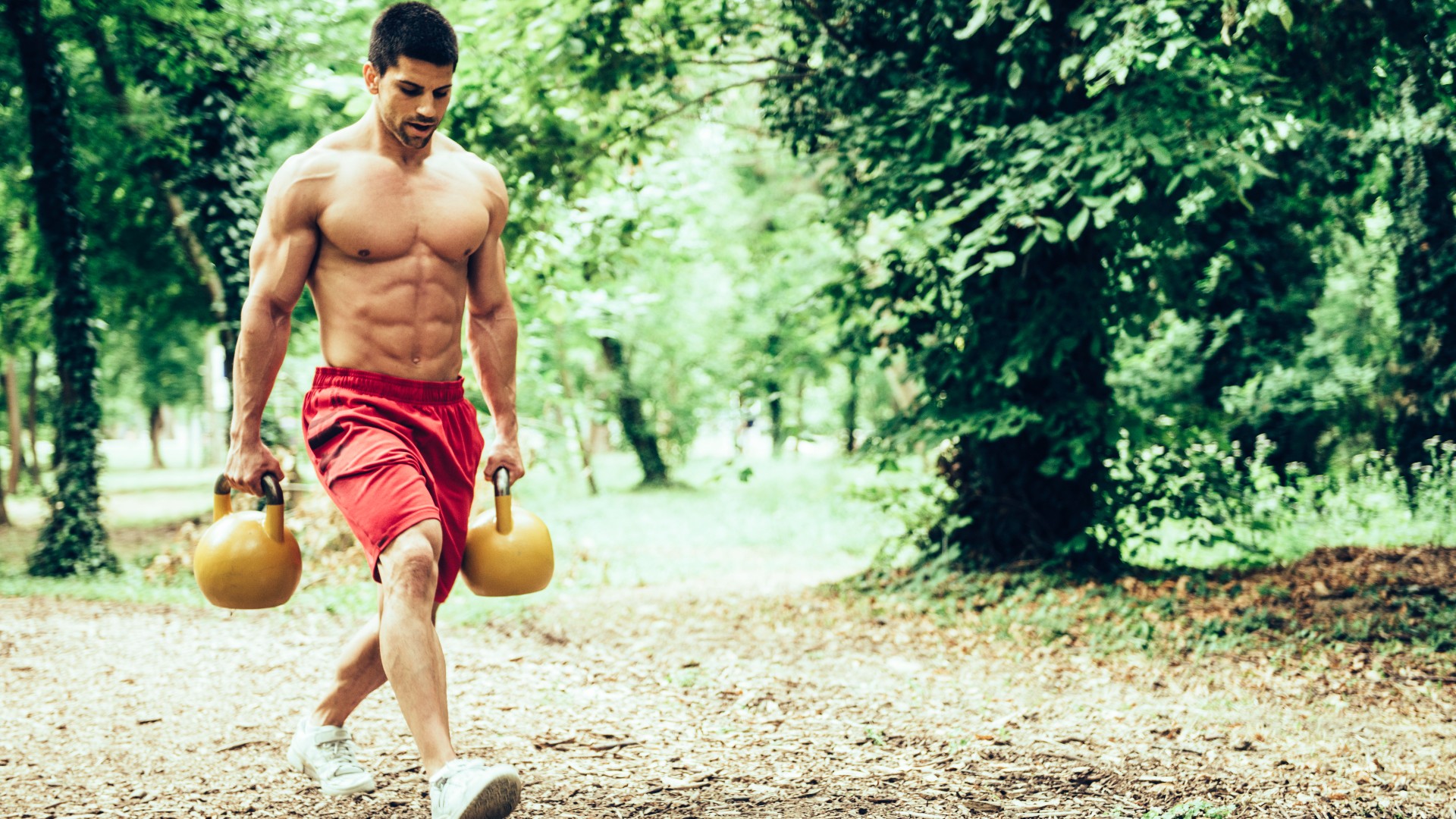
Push-ups and the bench press torch your pectorals, core and shoulder muscles, but the farmer's walk is one of my favorite full-body exercises for hitting these body parts and more.
The farmer's walk has traditionally been viewed as a shoulder exercise, but the move offers far more for your body. All you need to do is grip a trap bar or two heavy weights like the best adjustable dumbbells or kettlebells, and go for a walk. If you’ve ever carried your groceries home, then you're already familiar with that shoulder burn.
Also known as the farmer’s carry, the popular strength and conditioning move works far more muscles than your shoulders, also strengthening the muscles in your arms, back, legs and core muscles, and targeting your major muscle groups. It’s also a cardio exercise that can ramp up your heart rate and test overall endurance.
I decided to grab my weights and perform the farmer’s walk around my apartment every day for a week. Find out what happened to my body, or discover how 50 Arnold presses went down in another challenge.
Farmer’s walk: Benefits
The farmer’s walk is a versatile compound exercise used in functional training workouts like CrossFit and Hyrox. You can choose to carry two weights or challenge your balance and stability by working unilaterally (single-sided) by carrying one weight. Either way, strength gains are up for grabs. Other benefits of the farmer’s walk include building muscle, improving grip strength, and developing lower body power.
The move is considered an isometric and isotonic exercise; isometric refers to a static exercise that places your muscles under stress without the muscle lengthening or shortening (in this case, your shoulders and core muscles), whereas isotonic includes dynamic movement like walking.
Farmer’s walk: Muscles worked
Muscles worked in the farmer’s carry include your biceps, triceps and shoulder complex — the frontal, medial and lateral heads — rectus abdominis, oblique muscles, deeper core muscles, quadriceps, calves, hamstrings, glutes and back muscles like the erector spinae, traps, lats and even your chest (under heavier loads).
Get instant access to breaking news, the hottest reviews, great deals and helpful tips.
During a farmer’s walk, your shoulders are held under tension which challenges your postural stability, control and balance under load. Your other muscles, including your core and legs, are moving under that load, helping to build strength across your entire body. Research has shown that the farmer’s walk could be an ‘effective lifting alternative to the deadlift’ with less stress on your lower back muscles and similar activation.
How to do the farmer’s walk
You can use a range of weights, but we’ll use kettlebells as an example. Here's how to do the farmer's walk in more detail, and what happened when I tried the farmer's hold variation.
How:
- Stand with your feet hip-width apart and two kettlebells placed on either side of your feet
- Bend your knees and lower into a squat position with your chest proud and weight evenly distributed across your feet
- Grip both kettlebells, engage your core and set your shoulders back and down
- Keep your chest proud, look forward, and push the ground away to stand
- Begin walking with control and without leaning backward or over to one side.
I did the farmer's walk every day for a week — here’s my results
Walking works your entire body, as I found out doing the farmer’s walk every day.
Days 1 & 2
A move or workout that targets multiple muscle groups and joints at once is called a functional exercise, which perfectly sums up the farmer’s walk because we carry stuff every day. If you’re looking for ways to add functional movement to your next workout, try this calisthenics workout we swear by.
I decided to perform the farmer’s walk for 45 seconds with 15 seconds of rest and totaling eight sets, using my apartment to measure distance. If you prefer, you could also perform this exercise for a set distance or a set number of steps. I grabbed a pair of 35lbs kettlebells — a decision I would regret — and cracked on.
Beginners could opt for lighter weights or even shopping bags which is great if you want to achieve faster-paced cardio, but I decided to use it as a strong finisher to fatigue my muscles — mission accomplished.
My shoulders were on fire, but I also felt it in my legs, core, and back muscles the next day. Putting the weights down at either end of the apartment allowed me to add in a sneaky deadlift and I could also reset my shoulders and core. While it helped me keep my form tight, it did nothing to soothe achy muscles.
Days 3 & 4
By the fourth day, I was getting bored with my apartment (and my dog kept following me), so I graduated to the stairs outside. It wasn’t a surprise that I felt my quads and glutes working far harder, and I had to keep my core super tight to prevent the load from going into my lower back.
I preferred the activation in my lower body, so continued this way for the rest of the challenge, but I definitely noticed some curtain twitching from the neighbors. Maybe it was my heavy breathing?
Days 5 to 7
Although the first few sets felt comfortable, the last ones tested my posture, control, grip and core strength. There’s a lot to think about as you walk — keeping your core tight, shoulders set down and standing tall as you take steps forward while maintaining grip.
I have a rotator cuff injury in my left shoulder, so I immediately went into protection mode when noticing fatigue. It meant resetting the weights after each walk which helped me to adjust my shoulders, reengage my core and regrip the kettlebells.
Your rotator cuff muscles surround the shoulder joint and help to stabilize and support the shoulder through movement. When your primary working muscles begin to fatigue, any weak stabilizing muscles won’t be properly activated to support you.
Any internal shoulder rotation (slumping forward) prevents your rotator cuff muscles from properly switching on, which means other muscles might pick up the slack instead. As a result of taking extra precautions, I felt this exercise everywhere I wanted to without straining my shoulder or lower back. Although my grip strength still needs some serious work.
More from Tom's Guide
- This full-body workout takes just 30 minutes, 6 moves and 1 dumbbell
- If you fancy trying the farmer’s walk, why not add it as a finisher to this shoulder workout?
- And if you need more ways to recover, these are the best walking workouts we swear by.

Sam Hopes is a level 3 qualified trainer, a level 2 Reiki practitioner and fitness editor at Tom's Guide. She is also currently undertaking her Yoga For Athletes training course.
Sam has written for various fitness brands and websites over the years and has experience across brands at Future, such as Live Science, Fit&Well, Coach, and T3.
Having coached at fitness studios like F45 and Virgin Active and personal trained, Sam now primarily teaches outdoor bootcamps, bodyweight, calisthenics and kettlebells.
She also coaches mobility and flexibility classes several times a week and believes that true strength comes from a holistic approach to training your body.
Sam has completed two mixed doubles Hyrox competitions in London and the Netherlands and finished her first doubles attempt in 1:11.
